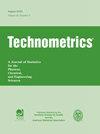图形化多保真高斯过程模型,应用于重离子碰撞仿真
IF 2.5
3区 工程技术
Q1 STATISTICS & PROBABILITY
引用次数: 0
摘要
摘要随着科学计算和数学建模技术的进步,星系形成和火箭推进等复杂的科学现象可以可靠地模拟。然而,这样的模拟可能非常耗时,需要数百万个CPU小时来执行。一种解决方案是多保真度仿真,它使用不同保真度的数据来训练一个有效的预测模型来模拟昂贵的模拟器。对于复杂的科学问题,在科学家的仔细启发下,这种多保真度数据通常可以通过表示其科学模型依赖关系的有向无环图(DAG)联系起来。因此,我们提出了一个新的图形化多保真高斯过程(GMGP)模型,该模型将DAG结构(捕获科学依赖关系)嵌入到高斯过程框架中。我们通过两个马尔可夫性质证明GMGP具有理想的建模特性,并且允许一种可扩展的算法用于沿DAG的每个深度水平递归计算后验均值和方差。我们还在给定实验预算的情况下提出了一种新的DAG实验设计方法,并通过深度高斯过程提出了GMGP的非线性扩展。GMGP的优势随后通过一系列数值实验和模拟重离子碰撞的应用得到了证明,重离子碰撞可用于研究大爆炸后不久宇宙中物质的状况。所提出的模型在具有图形结构的数据融合应用中具有更广泛的用途,我们将进一步讨论这一点。关键词:计算机实验,高斯过程,图形模型,核物理,多保真度建模,免责声明作为对作者和研究人员的服务,我们提供这个版本的已接受稿件(AM)。在最终出版版本记录(VoR)之前,将对该手稿进行编辑、排版和审查。在制作和印前,可能会发现可能影响内容的错误,所有适用于期刊的法律免责声明也与这些版本有关。本文章由计算机程序翻译,如有差异,请以英文原文为准。
A graphical multi-fidelity Gaussian process model, with application to emulation of heavy-ion collisions
AbstractWith advances in scientific computing and mathematical modeling, complex scientific phenomena such as galaxy formations and rocket propulsion can now be reliably simulated. Such simulations can however be very time-intensive, requiring millions of CPU hours to perform. One solution is multi-fidelity emulation, which uses data of different fidelities to train an efficient predictive model which emulates the expensive simulator. For complex scientific problems and with careful elicitation from scientists, such multi-fidelity data may often be linked by a directed acyclic graph (DAG) representing its scientific model dependencies. We thus propose a new Graphical Multi-fidelity Gaussian Process (GMGP) model, which embeds this DAG structure (capturing scientific dependencies) within a Gaussian process framework. We show that the GMGP has desirable modeling traits via two Markov properties, and admits a scalable algorithm for recursive computation of the posterior mean and variance along at each depth level of the DAG. We also present a novel experimental design methodology over the DAG given an experimental budget, and propose a nonlinear extension of the GMGP via deep Gaussian processes. The advantages of the GMGP are then demonstrated via a suite of numerical experiments and an application to emulation of heavy-ion collisions, which can be used to study the conditions of matter in the Universe shortly after the Big Bang. The proposed model has broader uses in data fusion applications with graphical structure, which we further discuss.Keywords: Computer experimentsGaussian processesgraphical modelsnuclear physicsmulti-fidelity modelingDisclaimerAs a service to authors and researchers we are providing this version of an accepted manuscript (AM). Copyediting, typesetting, and review of the resulting proofs will be undertaken on this manuscript before final publication of the Version of Record (VoR). During production and pre-press, errors may be discovered which could affect the content, and all legal disclaimers that apply to the journal relate to these versions also.
求助全文
通过发布文献求助,成功后即可免费获取论文全文。
去求助
来源期刊

Technometrics
管理科学-统计学与概率论
CiteScore
4.50
自引率
16.00%
发文量
59
审稿时长
>12 weeks
期刊介绍:
Technometrics is a Journal of Statistics for the Physical, Chemical, and Engineering Sciences, and is published Quarterly by the American Society for Quality and the American Statistical Association.Since its inception in 1959, the mission of Technometrics has been to contribute to the development and use of statistical methods in the physical, chemical, and engineering sciences.
 求助内容:
求助内容: 应助结果提醒方式:
应助结果提醒方式:


